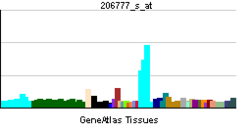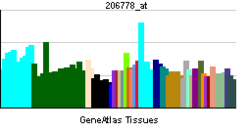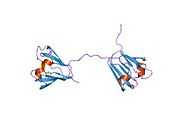CRYBB2
Beta-crystallin B2 is a protein that in humans is encoded by the CRYBB2 gene.[1][2][3]
Function
Crystallins are separated into two classes: taxon-specific, or enzyme, and ubiquitous. The latter class constitutes the major proteins of vertebrate eye lens and maintains the transparency and refractive index of the lens. Since lens central fiber cells lose their nuclei during development, these crystallins are made and then retained throughout life, making them extremely stable proteins. Mammalian lens crystallins are divided into alpha, beta, and gamma families; beta and gamma crystallins are also considered as a superfamily. Alpha and beta families are further divided into acidic and basic groups. Seven protein regions exist in crystallins: four homologous motifs, a connecting peptide, and N-terminal and C-terminal extensions. Beta-crystallins, the most heterogeneous, differ by the presence of the C-terminal extension (present in the basic group, none in the acidic group). Beta-crystallins form aggregates of different sizes and are able to self-associate to form dimers or to form heterodimers with other beta-crystallins. This gene, a beta basic group member, is part of a gene cluster with beta-A4, beta-B1, and beta-B3. A chain-terminating mutation was found to cause type 2 cerulean cataracts.[3]
Interactions
CRYBB2 has been shown to interact with Hsp27,[4] CRYGC,[4] CRYAA[4] and CRYAB.[4]
References
Further reading
- Datiles MB, Schumer DJ, Zigler JS et al. (1992). "Two-dimensional gel electrophoretic analysis of human lens proteins". Curr. Eye Res. 11 (7): 669–77. doi:10.3109/02713689209000740. PMID 1521468.
- Hulsebos TJ, Bijlsma EK, Geurts van Kessel AH et al. (1991). "Direct assignment of the human beta B2 and beta B3 crystallin genes to 22q11.2----q12: markers for neurofibromatosis 2". Cytogenet. Cell Genet. 56 (3-4): 171–5. doi:10.1159/000133080. PMID 2055112.
- Aarts HJ, Den Dunnen JT, Lubsen NH, Schoenmakers JG (1988). "Linkage between the beta B2 and beta B3 crystallin genes in man and rat: a remnant of an ancient beta-crystallin gene cluster". Gene 59 (1): 127–35. doi:10.1016/0378-1119(87)90273-3. PMID 3436525.
- Miesbauer LR, Zhou X, Yang Z et al. (1994). "Post-translational modifications of water-soluble human lens crystallins from young adults". J. Biol. Chem. 269 (17): 12494–502. PMID 8175657.
- Miesbauer LR, Smith JB, Smith DL (1993). "Amino acid sequence of human lens beta B2-crystallin". Protein Sci. 2 (2): 290–1. doi:10.1002/pro.5560020217. PMC 2142348. PMID 8443605.
- Kramer P, Yount J, Mitchell T et al. (1996). "A second gene for cerulean cataracts maps to the beta crystallin region on chromosome 22". Genomics 35 (3): 539–42. doi:10.1006/geno.1996.0395. PMID 8812489.
- Lampi KJ, Ma Z, Shih M et al. (1997). "Sequence analysis of betaA3, betaB3, and betaA4 crystallins completes the identification of the major proteins in young human lens". J. Biol. Chem. 272 (4): 2268–75. doi:10.1074/jbc.272.4.2268. PMID 8999933.
- Gill D, Klose R, Munier FL et al. (2000). "Genetic heterogeneity of the Coppock-like cataract: a mutation in CRYBB2 on chromosome 22q11.2". Invest. Ophthalmol. Vis. Sci. 41 (1): 159–65. PMID 10634616.
- Hanson SR, Hasan A, Smith DL, Smith JB (2000). "The major in vivo modifications of the human water-insoluble lens crystallins are disulfide bonds, deamidation, methionine oxidation and backbone cleavage". Exp. Eye Res. 71 (2): 195–207. doi:10.1006/exer.2000.0868. PMID 10930324.
- Vanita , Sarhadi V, Reis A et al. (2001). "A unique form of autosomal dominant cataract explained by gene conversion between beta-crystallin B2 and its pseudogene". J. Med. Genet. 38 (6): 392–6. doi:10.1136/jmg.38.6.392. PMC 1734905. PMID 11424921.
- Fu L, Liang JJ (2002). "Detection of protein-protein interactions among lens crystallins in a mammalian two-hybrid system assay". J. Biol. Chem. 277 (6): 4255–60. doi:10.1074/jbc.M110027200. PMID 11700327.
- MacCoss MJ, McDonald WH, Saraf A et al. (2002). "Shotgun identification of protein modifications from protein complexes and lens tissue". Proc. Natl. Acad. Sci. U.S.A. 99 (12): 7900–5. doi:10.1073/pnas.122231399. PMC 122992. PMID 12060738.
- Fu L, Liang JJ (2003). "Unfolding of human lens recombinant betaB2- and gammaC-crystallins". J. Struct. Biol. 139 (3): 191–8. doi:10.1016/S1047-8477(02)00545-2. PMID 12457849.
- Srivastava OP, Srivastava K (2003). "BetaB2-crystallin undergoes extensive truncation during aging in human lenses". Biochem. Biophys. Res. Commun. 301 (1): 44–9. doi:10.1016/S0006-291X(02)02975-3. PMID 12535638.
- MacDonald JT, Purkiss AG, Smith MA et al. (2005). "Unfolding crystallins: The destabilizing role of a β-hairpin cysteine in BetaB2-crystallin by simulation and experiment". Protein Science 14 (5): 1282–1292. doi:10.1110/ps.041227805. PMC 2253261. PMID 15840832.
PDB gallery |
|---|
| | 1bd7: CIRCULARLY PERMUTED BB2-CRYSTALLIN |
| 1blb: CLOSE PACKING OF AN OLIGOMERIC EYE LENS BETA-CRYSTALLIN INDUCES LOSS OF SYMMETRY AND ORDERING OF SEQUENCE EXTENSIONS |
| 1e7n: THE N-TERMINAL DOMAIN OF BETA-B2-CRYSTALLIN RESEMBLES THE PUTATIVE ANCESTRAL DIMERIC |
| 1ytq: Structure of Native Human Beta B2 Crystallin |
| 2bb2: X-RAY ANALYSIS OF BETA B2-CRYSTALLIN AND EVOLUTION OF OLIGOMERIC LENS PROTEINS |
|
|
|
|
|---|
| | Opsin (retinylidene protein) | |
|---|
| | Crystallin | |
|---|
| | Other | |
|---|
| |
|---|
| | Description |
- Anatomy
- Physiology
- Phenomena
- appearance
- visual
- optical illusions
- proteins
- Development
|
|---|
| | Disease |
- Congenital
- Corneal dystrophy
- Neoplasms and cancer
- Other
- Symptoms and signs
|
|---|
| | Treatment |
- Procedures
- Drugs
- infection
- glaucoma and miosis
- mydriatics
- vascular
|
|---|
|
|







